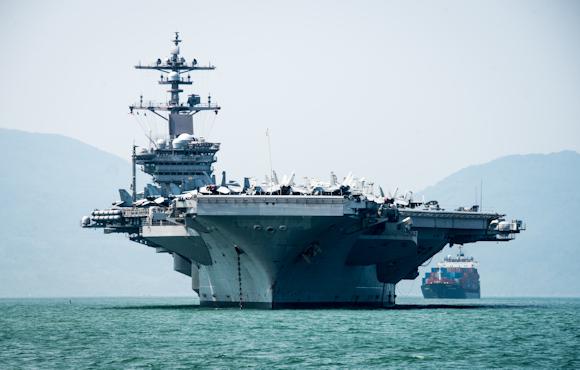For England, the great vessels of the age of sailing ships (from the late seventeenth century to the mid nineteenth), who came to touch the 5.500 tons of displacement, with a total of 100 guns arranged on 3 or 4 bridges of battery, have been the main instrument of the conquest of a world leadership that the United Kingdom will maintain practically until the Great War, becoming the guarantor of an international structure structured around the concept of balance of power balance, political-diplomatic pin of the so-called British Pax.
The thirty-year period marked by two world wars ended with the acknowledgment of the change in economic power relations on the international scene, which will receive its monetary sanction in July of 1944 with the "agreements" of Bretton Woods, based to which the dollar ousted the pound by imposing itself as a new currency of trade and financial exchange.
This transfer of deliveries reflected a dynamic in the relations between powers that even then, more than a year after the end of the fighting with the surrender of Japan in August of 1945, had now clearly outlined on the battlefields. In the various theaters of confrontation between the military apparatuses of the great powers, the aircraft carriers have turned out to be one of the key factors of that redefinition, ended with the definitive exchange between Great Britain and the United States at the top of the new world hierarchy that will have Washington consensus one of its characterizing traits.
Before the union between maneuverability and firepower, embodied by the binomial sails-cannons, became the decisive factor, the naval battles were decided by ramblings and arrembaggi. Infantry embarked, rostra, hooked platforms and grapples, have embodied for many centuries, together with the ship of which they were the equipment, the essence of maritime power that, from its origins as a conceptual category of the art of war, it was manifested as a result of the operational interpenetration of the different dimensions involved in the clash between men in arms.
The acceleration of technological-military innovation from the Industrial Revolution has accentuated the need for inter-operative operational coordination since the beginning of the industrialization of war.
[...] almost all the great military campaigns of the modern era were the result of a combined effort: for example, when General Ulysses Grant joined the Union navy to descend along the Mississippi and take the Confederates behind; or in the case of the daring landing of McArthur in Inchon during the Korean War; and above all in the biggest combined operation ever: D-Day (Colin Powell, "An enfant du Bronx", Odile Jacob, 1995).
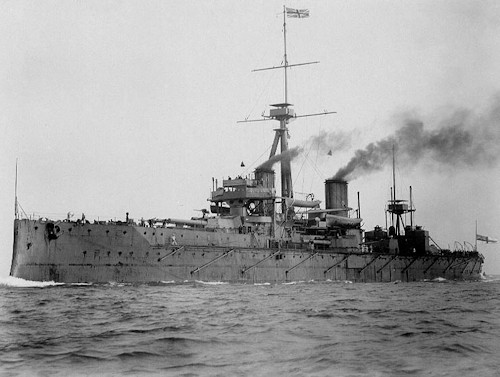 With its combination of monoculars cannons (higher than 305 mm), for the main battery, hulls with steel armor, remarkable speed and wide range of action, the armored type dreadnought - whose first model was launched in February of the 1906 to join the Royal Navy team in the following December - represents the culmination of the constructive history of naval units that reflected the search for the most effective synthesis of the military endowments of the time, developed in the course of an era in which the war theaters were "two-dimensional".
With its combination of monoculars cannons (higher than 305 mm), for the main battery, hulls with steel armor, remarkable speed and wide range of action, the armored type dreadnought - whose first model was launched in February of the 1906 to join the Royal Navy team in the following December - represents the culmination of the constructive history of naval units that reflected the search for the most effective synthesis of the military endowments of the time, developed in the course of an era in which the war theaters were "two-dimensional".
Also in the terrestrial field the maximum operational advantage will be pursued through the combination of armor, cannon and mobility, realized in the tank that for its tactics of employment, but also for the fact that the funds for its realization, in England of the First World War, were made available by the Admiralty (of which from the 1911 to the 1915 was First Lord Winston Churchill), it was called "terrestrial war ship".
During the Second World War, naval terminology is still used to define the operational functionality of armored vehicles equipped with cannons and machine guns. One example is the "light cruiser wagon" MK VII Tetrarch, employed - to be honest with no particularly brilliant results - on the occasion of the landing in Normandy, the 6 June 1944.
Made by the British Vickers-Armstrong (engineering conglomerate with a world-wide presence in the shipbuilding industry), this tank did not have much constructive luck, despite being an excellent product, especially in the amphibious version that boasted a mechanics so valid that it was also adopted for corresponding American tanks Sherman.
With the arrival of the aviation scene, whose birth certificate is symbolized by the flight carried out by the Wright brothers in January of the 1903, we did not have to wait long for the first aircraft to be invited to embark, especially by virtue, in this initial phase , of the reconnaissance potential offered by the air transport.
The decisive stimulus was provided by the postal service on the Hamburg-New York route, to accelerate which, in 1910, it was decided to take off a plane from the forward deck of one of the steamers used for the delivery of correspondence. Given that for some time the warning signs of a new conflict were becoming clearer and clearer, the American military leaders presented this innovation as a disguised attempt by the Germans to develop a new technique of attack against the United States.

Captain Washington Chambers, head of the US Navy Materials and Equipment Department, obtained permission for a series of drills to take off an aircraft from a warship. The light battleship was chosen Birmingham on the side of which was mounted a platform for the long takeoff 25 meters and 7 wide, while the pilot would be Eugene B. Ely who worked as a test in the company of Glenn Curtiss, another important figure among aviation pioneers.
Ely made the first take-off in the history of a military ship the 14 November 1910 (photo), in the Chesapeake Bay, off Hampton Roads (Virginia), and just over two months later, the 18 January 1911, passed by winning the primate also in the fitting (an operation that in fact presented, and still presents, greater difficulties), posing with its propeller biplane Curtiss on the ramp, long 36 meters and 10 wide, installed aft of the battleship Pennsylvania, moving in the San Francisco bay.
For his demonstrated ability to work as a team taking the step of the formation of the English fleet, it is believed that the Campania can boast the title of the first aircraft carrier in history. However, it was still a passenger ship of the Cunard company that had decided to save from scrapping by converting it into aircraft carriers, in order to be able to benefit from fuel holds capable of containing the amount of fuel needed for the crossing of the Atlantic and a system of propulsion that allowed to touch the 22 nodes, despite some "ailments" suffered by the engine room.
The first military ship designed specifically as an aircraft carrier, commissioned by the Royal Navy in the 1917 and commissioned in January of the following year, was the Hermes. This unit reached the 25 nodes, could transport twenty aircraft and was equipped with a single bridge that went from stern to bow but, unlike for example that ofArgus, it was not completely uncluttered and received a "islet" superstructure, a solution that over time will become the standard configuration for this category of ships.
It was observed that in case of problems during the fitting, the majority of pilots tends to turn left, with the result that the placement of the island in the starboard position allowed to reduce by 50% the number of accidents in relation to the amount of maneuvers performed, compared to the port side solution. In the 50 years a further halving of the accident rate in the re-entry phase will be achieved thanks to the introduction of the oblique flight bridge (angled with a rotation of 8-10 degrees with respect to the longitudinal axis of the vessel), and of the fitting mirror .
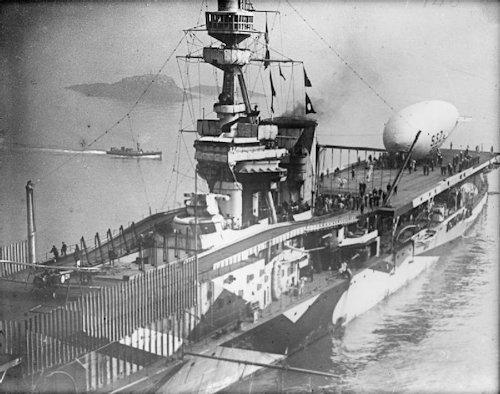 Instead, it is up to the French, who perfected what had been experienced on English Furious (photo) in the 1917, the fine tuning, between the end of the years 20 and the early years' 30, of the system of stop through a series of transversal cables for the coupling of the aircraft in assembling, which proved to be more effective than the device longitudinal up to then in use. The new equipment, combined in any case with a safety barrier positioned on the flight deck in order to stop the running of the missing cables, significantly speeded up the operations allowing two aircraft to take off and run simultaneously and in the 1933 had already been also adopted by Americans, Japanese and English.
Instead, it is up to the French, who perfected what had been experienced on English Furious (photo) in the 1917, the fine tuning, between the end of the years 20 and the early years' 30, of the system of stop through a series of transversal cables for the coupling of the aircraft in assembling, which proved to be more effective than the device longitudinal up to then in use. The new equipment, combined in any case with a safety barrier positioned on the flight deck in order to stop the running of the missing cables, significantly speeded up the operations allowing two aircraft to take off and run simultaneously and in the 1933 had already been also adopted by Americans, Japanese and English.
In the final phase of the First World War, a British air-sea attack force became the protagonist of the first raid against a terrestrial target made by planes taken off a ship. In the early hours of the 19 July 1918 morning, a squadron of six fighters Camel 2 F. 1 (version for the Marina del Camel Sopwith terrestre), took off from the aircraft carrier Furious (derived from the conversion of a cruiser), and dropped their cargo of bombs on the named hangars Toska e Tobias, of the Tondern base (now a Danish citizen), in Schleswig-Holstein, destroying the Zeppelin airships L.54 e L.60 and an observation ball.
During the conflict, the ranks of His Majesty's Navy also began to formulate plans for air raids to be carried out directly in the berthing ports of the German fleet, through the use of aerosilants. In October of the 1916, Commodore Murray Sueter delivered a memorandum to the aeronautical company Sopwith on which to base the design of an aircraft capable of carrying up to two torpedoes, with a range of four hours.
Sopwith built the requested apparatus albeit too close to the armistice that put an end to hostilities. However, the 90 assembled specimens of the new aircraft - baptized Cuckoo (Cucù) for his ability to "lay eggs" in the nest of others - immediately aroused great interest among the Japanese Armed Forces and the Japanese Navy in the 1922 bought six units.
The 10 April of the 1940, a squadron of 15 dive bombers Skua, produced by the British Blackburn Aircraft Limited, took off from the Orkney islands where they had been disembarked from the aircraft carrier Ark Royal in March, they became protagonists of the first sinking by air attack of an important warship: the German cruiser Königsberg, targeted in the waters of the Norwegian port of Bergen.
The positive outcome of this action, Sueter's studies and the assembly of the first squadron of aircraft that celebrated the air-torpedo binomial, led to the development of attack groups based on aircraft carriers capable of launching raids against the main ports of anchor of an enemy fleet.
It was precisely the Marines of the two island powers (with the British still in the role of inspiration for the Japanese military summits), to perfect this technique of use of the aeronaval device, as demonstrated by the victorious raids against the Italian and American fleets, respective bases of Taranto (operation Judgement, photo), and Pearl Harbor, the 11-12 November 1940 and the 7 December 1941.
Assuming respect for the precondition of a state-of-the-art design, as well as winning a team of Formula 1 is the combination of the skill of the pilots with the expertise and dedication to the work of the team of technicians and mechanics of the box, the readiness the risk and operational effectiveness of an aircraft carrier are the result of the professionalism andesprit de corps (both in roadstead and in a mission theater), platform personnel, combined with the skill of pilots of the air force boarded.
Among the plurality of factors that contributed to the American victory in the Midway battle of the 4 June 1942, figure the speed with which it was put back in a position to sail the aircraft carrier Yorktown (CV-5). This unit had been seriously damaged (along with the Lexington which ended up sinking), at the Battle of the Coral Sea, at the beginning of May of the same year, and was considered permanently out of the game by the Japanese information service.
Instead the Yorktown (photo below) managed to return to the Pearl 27 May and found shelter in the dry dock n. 1, where a repair team of the order of magnitude of a battalion, formed by 1.400 port workers armed with pneumatic hammers and welding torches, they patched the hull, reinforcing the damaged compartments with wooden beams. Although there were few watertight doors working due to the deformation caused by the Japanese devices, the Yorktown, with Admiral Frank Fletcher commander of the 17 on boardth Task Force, returned to sail the waters of the Pacific on May 29, after 48 hours of stay in the roadstead, against the 90 days originally estimated.
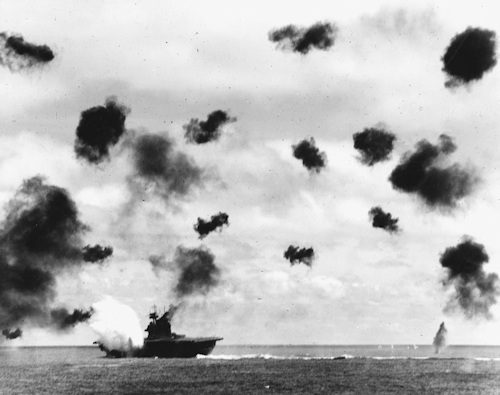 The outcome of the Battle of Midway could not but decisively influence the course of the war in the Pacific, considering that the magnitude of the Japanese losses came to exceed the ability to recover in time the war machine of the Rising Sun which was destroyed four large aircraft carriers on six supplied to Rengo Kantai (Flotte Riunite).
The outcome of the Battle of Midway could not but decisively influence the course of the war in the Pacific, considering that the magnitude of the Japanese losses came to exceed the ability to recover in time the war machine of the Rising Sun which was destroyed four large aircraft carriers on six supplied to Rengo Kantai (Flotte Riunite).
Even more serious was the loss of 260 devices on the 325 deployed on the flight decks, and above all of their crews who, with a budget of 180 dead and wounded 80, saw to put out almost 45% of the elite body of the Navy Japanese, consisting of 600 official first-class aviators out of a total of 5.000, of which 3.500 were in service as front-line pilots.
To remedy this catastrophe, attempts were made to speed up the insertion of the replacements, initially reducing the flight hours of the intermediate training course, and then even canceling the advanced training stages. In practice, after completing the basic training course, the newly patented were sent directly to the combat departments, where a short tactical training course was planned before taking action.
The results, however, could only be poor, because the shortage of high-level drivers was inevitably reflected in the lack of instructors able to convey to the students the wealth of experience necessary to move from the standard biplanes, supplied to the flight schools, to combat aircraft and ground attack (whether this is land or water), used in battle.
In the second half of the 1943, the Japanese Navy recorded a doubling of losses due to accidents in training and the 1944 opened with a further deterioration. We then tried to run for cover by restoring the entirety of the phases of which the training programs of the students were made, but the situation was compromised to such an extent that some of the aircraft carriers launched between the 1943 and the 1944 found themselves short of riders for their aircraft.
A share of aviators belonging to the new levers had entered the service knowing how to take off but without the necessary experience to set up safely and during the battle of the Gulf of Leyte, in October of 1944, some units found themselves completely without a air force boarded. After all, at that point the military parabola of Japan had long been in the descending phase across the board, with many departments of its Armed Forces that now also lacked fuel.
The United States could count on a large recruitment area consisting of a large and growing population that was generally sufficiently educated. With the outbreak of the conflict two new flying schools were founded, in Corpus Christi, Texas, and in Jacksonville, Florida, where the American aviation training center of Pensacola was already located. In the middle of the 1943, the total number of students enrolled in the courses organized by the three institutes had reached the 45.000 aspiring pilots.
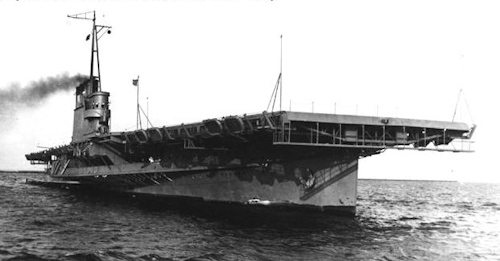 The final phase of a long training course included the transfer of students to Glenview, Illinois, to practice the fitting on the only two fresh water carriers of the world obtained by the transformation of two steamers into school-ships, the Greater Buffalo and Seeandbee, built for navigation in the waters of the Great Lakes. The two ex lakers, renamed Sand e Wolverine (photo), were moored along the shores of Lake Michigan where future pilots of air-sea units, known as carquals (from the contraction of carrier qualification), performed their exercises until they were totaled from 360 to 450 hours of flight during the training period.
The final phase of a long training course included the transfer of students to Glenview, Illinois, to practice the fitting on the only two fresh water carriers of the world obtained by the transformation of two steamers into school-ships, the Greater Buffalo and Seeandbee, built for navigation in the waters of the Great Lakes. The two ex lakers, renamed Sand e Wolverine (photo), were moored along the shores of Lake Michigan where future pilots of air-sea units, known as carquals (from the contraction of carrier qualification), performed their exercises until they were totaled from 360 to 450 hours of flight during the training period.
Finally, after obtaining the pilot qualification, a first six month appointment service was foreseen at a ground-based squadron operating in collaboration with a boarded formation. Only at the end of this further period did one enter the full crew of an aircraft carrier.
The dual use of aircraft carriers in the Pacific and Atlantic ocean theaters during the Second World War, highlighted all the potentialities in terms of operational flexibility offered by the naval combat device that proved to be decisive both in the clash between exponents of the same species, how much in contrast to the wars de course.
With the outbreak of the conflict, the Atlantic Ocean was confirmed as the favorite hunting ground for the German U-Boote submarines, whose class of greatest operational importance and numerical consistency was constituted by the exemplars of the Type VII, and that at the end of the hostilities will come to take on the appearance (seen for example the removal of the cannon on the bridge), and the capacity of action of real submarine vessels, with the appearance of the units of the Type XXI but that they were born too late even to try to assert themselves adequately on the battlefield.
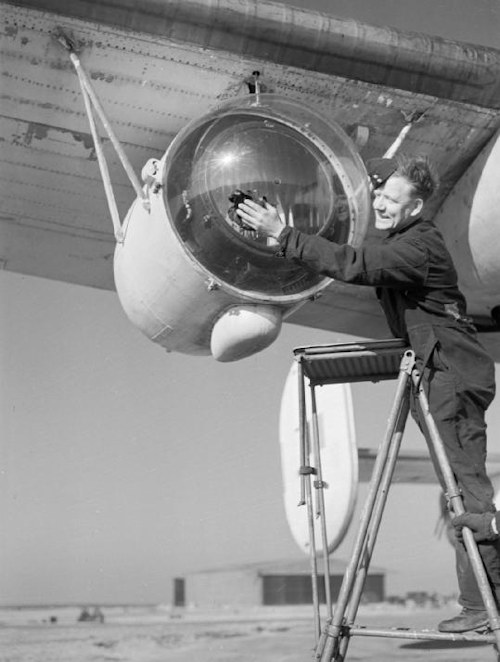
In the real movement of the events that make up a war, especially when it comes to a large-scale conflict, the continuous chasing between the development of certain threats and the appearance of the relevant countermeasures highlights well through the process dialectic of competition between attack and defense, how much by their nature are integrated the different dimensions that military doctrine identifies as components of a theater of operations.
The best U-Boote raid countermeasure did not come from the sea but from the air, in the form of long-range reconnaissance and bombers (like the Consolidated B-24 Liberator), defined by the same admiral Karl Dönitz: the greatest threat to submarines. Thanks to the radar and the modern radio communication and espionage instruments, these aircraft transformed German submarines from predators into prey (photos).
The "wolves of wolves" were pushed to take refuge in the "Atlantic pit" (or "black hole" if you prefer), a corridor about 1.000 km wide that crossed the central part of the Atlantic, going from the north (between the island Canadian Terranova and Iceland), in the Azores area, out of reach of the planes that operated from the allied land bases of the two coasts.
In order to flush out the U-Boote from their sanctuary, specialized aircraft units were used in the escort of the convoys (Escort Carrier or CVE), designed for the first time in the United Kingdom to counter the incursions of the German long-range air squadrons formed from Focke-Wulf Condor who, operating from their bases on the French coast, carried out reconnaissance aimed at identifying targets for the U-Boote and also acting "on their own" by attacking the British merchant shipping off the English west coast, beyond the range of the His Majesty's earthly aviation.
Thus, in the 1941, the Royal Navy deployed theAudacity (derived from the German banana factory Hanover), whose six fighters Martlet II (English name of the Grumman F4F Wildcat), proved to be able to break down the FW Condor and to carry out patrols to report the presence of German submarines.
THEAudacity it was sunk in December of the same year but its short operational life proved the validity of the project. By employing such units in the Battle of the Atlantic, the Allies were able to assure continuous air coverage of their convoys from one coast to the other of the ocean, and even hit the U-Boote in their last hunting reserve.
The CVE played a major role also in the improvement of the techniques of combined attack on amphibious operations, for the success of which it was necessary to ensure adequate air coverage to the landing forces.
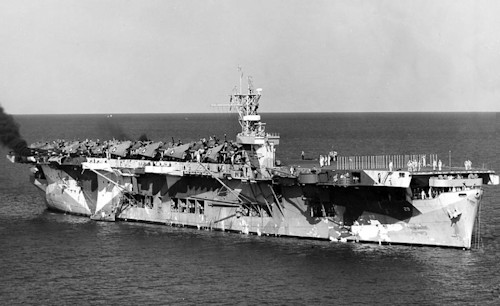 In November of the 1942, during the operation Torch, conducted against enemy coasts in North Africa, the Allied assault troops benefited from the air support provided by Anglo-American naval training based on two groups of support aircraft and escort. The British deployed the units Briter, Dasher e Avenger (backed byArgus), with their 45 Hawker Sea Hurricane, 12 Supermarine Seafire and 3 Fairey Swordfish. The contribution of the US Navy was represented by the corresponding units of the class Sangamon (made by converting oil tankers whose powerful propulsion system increased their operational capacity compared to the previous class), named Sangamon, Suwannee e Santee (photo), which transpotavano: 55 Wildcat, 26 Grumman Avenger and 18 Douglas SBD Dauntless.
In November of the 1942, during the operation Torch, conducted against enemy coasts in North Africa, the Allied assault troops benefited from the air support provided by Anglo-American naval training based on two groups of support aircraft and escort. The British deployed the units Briter, Dasher e Avenger (backed byArgus), with their 45 Hawker Sea Hurricane, 12 Supermarine Seafire and 3 Fairey Swordfish. The contribution of the US Navy was represented by the corresponding units of the class Sangamon (made by converting oil tankers whose powerful propulsion system increased their operational capacity compared to the previous class), named Sangamon, Suwannee e Santee (photo), which transpotavano: 55 Wildcat, 26 Grumman Avenger and 18 Douglas SBD Dauntless.
From an industrial-financial point of view, the aircraft carriers are an "ugly beast", both for the constructive complexity and for the high costs that inevitably accompany it, for this reason, practically since their appearance, they cyclically try to convince themselves that they are useless. Moreover, by their very nature, unlike what can be true for the systems on board, with regard to the costs of the platform you can not rely much on economies of scale.
After the Second World War only the United States could afford a double-digit aircraft carrier fleet, and exceeding the threshold of 100 units built in the first half of the '40 years (of all types and considering both those built and following the best practices that the derivations from other types of ships), was made possible by the enormous resources available to the rising American continental power, combined with the exceptional nature of a historic moment marked by total mobilization for the Second World War.
 The recurring icon of the thirties, the "Madonna of Depression", gave way to the propagandistic ideal of the woman who worked for the war effort, "Rosie the Rivettatrice" (even if given the changes in working practice, "Rosie the Welder "Would have been a more appropriate name) (Richard Overy, "The Road to Victory", the Mill, 2011).
The recurring icon of the thirties, the "Madonna of Depression", gave way to the propagandistic ideal of the woman who worked for the war effort, "Rosie the Rivettatrice" (even if given the changes in working practice, "Rosie the Welder "Would have been a more appropriate name) (Richard Overy, "The Road to Victory", the Mill, 2011).
In the two-year 1943-1944, Japan built 7 aircraft while the United States produced 90. In the fire of the Second World War, in addition to the troops deployed on the battlefields, armies of workers framed in the opposing economic-productive apparatuses that supported the military machine of the warring parties also faced each other.
Given Overy's reference to the figure of Rosie the Riveter, it is worth pointing out that the ranks of these particular fighting forces reached the necessary consistency only thanks to a strong increase in female employment, which had important repercussions from the point of view of social relations.
Suffice it to say that in the US all publishers were invited to give maximum emphasis to every possible job opportunity for women, in line with the slogan that stood out on posters and propaganda leaflets: the more women will be at work and the sooner we will win (the more women at work, the sooner we win).
From this derives an emblematic implication of the complexity of the effects on social change, generated by the multiple dialectical connections that are intertwined in a war event. With the accelerated insertion of women into the world of work, set in motion by the recruitment of war, the two world carnage ended up becoming just as many turning points in the history of women's emancipation struggles.
Returning to the aeronaval industry, in comparative studies of different military devices, it is not correct to compare the cost of an aircraft carrier with that of the operating equivalent expressed by a number of aircraft in land configuration (fixed and rotary wing), equal to the host from the naval platform.
As a floating air base, an aircraft carrier confers operational flexibility and speed of risk to the projection force of a great power, freeing it (albeit within certain limits), from the political problems related to the possibility of using a land based abroad, as well as set-up costs and maintenance of this installation. Thus, the comparison between the different types of investment in question should be parametrized on life cost cycle of an aircraft carrier in relation to that of the entire structure of an air base of land.
Moreover, the large amount of resources mobilized in the construction and subsequent maintenance of an aircraft carrier, generates important industrial and occupational repercussions, so much so that, the staging and periodic revisions to which these units are subjected, take part in the competition between exponents politicians fighting each other for the conquest and consolidation of their own territorially rooted electoral base.
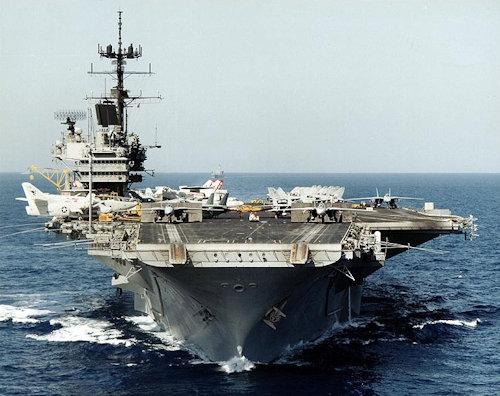 In his autobiography, Colin Powell says that in the 1979, during an important modernization intervention concerning the Saratoga (CVA-60 - photo), the feasibility studies conducted by the US Navy had identified the sites in Norfolk, Virginia, as an industrial site that presented the greatest economic advantage for the execution of the works.
In his autobiography, Colin Powell says that in the 1979, during an important modernization intervention concerning the Saratoga (CVA-60 - photo), the feasibility studies conducted by the US Navy had identified the sites in Norfolk, Virginia, as an industrial site that presented the greatest economic advantage for the execution of the works.
The then secretary to the Navy, Graham Clayton, agreed with the conclusions of the technicians of the Arma, but Walter Mondale, vice president in the administration led by Jimmy Carter, during the election campaign had promised the inhabitants of Philadelphia that the contract for the reconstruction of the Saratoga would have been entrusted to the naval establishments of their city.
A new report was then drawn up (signed by Powell, then assistant to Charles Duncan, secretary of the Department of Energy), in favor of the Pennsylvania shipbuilding industry, and so that there were no doubts about who should thank the citizens of Philadelphia for the 'award of this contract, Walter Mondale positioned himself in a beautiful view on the bridge of the Saratoga during its entry into the dry dock.
During the 1991 Gulf War, the Saratoga, together with his class leader Forrestal (CVA-59), was part of the aeronaval projection force deployed by the US and made up of a fleet that exceeded the 70 units, including 7 aircraft carriers. The contribution of aviation embarked during the conflict is quantifiable in about half of the entire potential offensive aircraft and over two Attack Carrier already mentioned, were mobilized: the Midway (CV-41), la John F. Kennedy (CV-67, the latest conventional propelled aircraft carrier built for the US Navy), the Roosevelt (nuclear-powered attack carrier, CVN-71), America (CVA-66) and the Cleaning (CV-61).
The implosion of the USSR and the consequent dissolution of the Soviet sphere of influence could only lead to the reignite of political contrasts (with related ethnic-religious feuds), which historically affect the area that goes from the Balkans to the Caucasus, shared regions ( so much so that the latter was defined as "the Balkans of the East", by the presence of a plurality of failed states that make them areas of almost endemic instability.
The declarations of independence by Slovenia and especially Croatia at the end of June of the 1991 followed a reaction of Serbia resulting in a war whose first phase will end at the beginning of the 1992, but the fighting, linked to the precipitate of the situation in Bosnia-Herzegovina, will end only the 5 November 1995 with the Serb acceptance of the cease-fire which will follow the peace agreements of Dayton (Ohio), formalized in December of the same year.
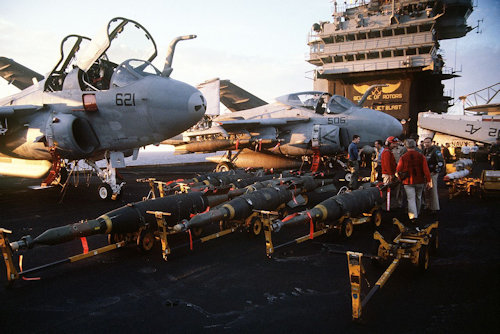 In the context of the various international missions that affected the former Yugoslavia in that period, the United States deployed in the Adriatic Task Force 60 (framed in the Sixth Fleet, operating in the Mediterranean), with the aircraft carrier Kennedy (photo), the 7 1992 October XNUMX sailed from Norfolk, in the role of flagship, until April of the following year that saw the Roosevelt (photo), in turn subsequently detected by the Saratoga under the orders of Admiral Bill Wright.
In the context of the various international missions that affected the former Yugoslavia in that period, the United States deployed in the Adriatic Task Force 60 (framed in the Sixth Fleet, operating in the Mediterranean), with the aircraft carrier Kennedy (photo), the 7 1992 October XNUMX sailed from Norfolk, in the role of flagship, until April of the following year that saw the Roosevelt (photo), in turn subsequently detected by the Saratoga under the orders of Admiral Bill Wright.
Both in the preparatory phase, from the October 1998 up to the beginning of March of the '99, that during the operations related to the Kosovo War (NATO Allied Force mission), from the 24 March to the 3 June 1999, the US TF 60 that among its ranks included the Eisenhower (CVN-69), coordinated with the Franco-British team TF 470, led by the Marine Nationale who had fielded the aircraft carrier Foch.
The 19 March 2011 kicked off, under US direction, the NATO mission Odissey Dawn, which was followed by the 31 of the same month, Unified Protector European guide. The US Navy has made available to OD the Expeditionary Strike Group 5, naval team based on the 26th Marine Expeditionary Unit, amphibious assault aircraft carrier LHD-3 (Landing Helicopter Dock), Kearsarge of the class Wasp, which boarded six AV-8Bs Harrier from interdiction.
La Kearsarge it was flanked by destroyers Barry (DDG-52), e Stout (DDG-55), class Arleigh Burke, from attack nuclear submarines (equipped with missiles Tomahawk), scranton (SSN-756), e Providence (SSN-719), class Los Angeles, and referred to the post-command ship Mount Whitney (LCC / JCC-20).
It seems Italians were the first to take an interest in the potential of rotary wing aircraft as a registered air force. Indications in this sense are already found in official documents of the early '20 and in the 1935 the Royal Navy experimented, in La Spezia, the use on the cruiser River autogiro designed by the Spanish Juan de la Cierva who had patented it in the 1920.
The basic idea was first and foremost to improve the safety of the "heavier than air" flight, obviating in particular the problem of stalling. At that time De la Cierva built a "hybrid" device made up of a plane equipped with a propeller placed above the aircraft and capable of guaranteeing a continuous lift, even in the absence of an application of power thanks to the self-rotation phenomenon. To overcome the problem of the difference in bearing capacity of the blades in autorotation, the Iberian manufacturer installed two counter-rotating overlapping rotors.
 The double counter-rotating coaxial rotor architecture will become a hallmark of the Kamov helicopters, whose most famous model is the Ka-50 Werewolf (photo), but the Soviet manufacturer (from the Russian 1991-'92), has distinguished itself in general for the realization of an articulated series of machines destined for naval use, especially in the anti-submarine fight.
The double counter-rotating coaxial rotor architecture will become a hallmark of the Kamov helicopters, whose most famous model is the Ka-50 Werewolf (photo), but the Soviet manufacturer (from the Russian 1991-'92), has distinguished itself in general for the realization of an articulated series of machines destined for naval use, especially in the anti-submarine fight.
However, the Americans were the first to fine-tune the technique of "vertical assault" through the rapid redeployment of eliped troops, but it will be at the Royal Navy to take charge of the debut of the new device in a theater of war. The occasion presented itself with the Suez crisis, during which the British employed the aircraft carriers Eagle, Albion e Bulwark, while the French deployed the units Arromanches e Lafayette.
The 6 November 1956, 600 British Navy Riflemen were disembarked from a squadron of 22 helicopters Whirlwind (produced by Westland under license of the US Sikorsky), and Sycamore (developed after the Second World War by the Bristol Airplane Company), which, making the most of the surprise effect, after the first hour and a half had already transported to 415 men and 20 tons of material (mostly ammunition).
In the entire operation the Royal Navy lost only one helicopter and the rotary wing aircraft was also noted for another performance of great importance for the operational future of these machines: a wounded rifleman found himself in the infirmary of the aircraft carrier after 19 minutes from his evacuation from the battlefield.
In his analysis of the operations conducted by the Marine Nationale during the Kosovo War, Admiral Alain Coldefy (then commander of the TF 470), draws attention to some teachings that a projection force (at first French but in European perspective), can draw from that experience.
At the time it was the greatest to argue that now it would operate in the Mediterranean, easily accessible in all its parts directly from the metropolitan area. The 1999 operation demonstrated the importance of the aircraft carrier, even in the European theater of intervention [...] The deployment in the Adriatic, in a position close to the Yugoslavian coasts, has proved decisive in the conduct of the operations, allowing a reactivity, a persistence and a flexibility of intervention without equal ("Les opérations de la Marine nationale devant le Kosovo en1999: le rôle du Groupe Aéronaval", in "Entre terre et mer, L'occupation militaire des espaces maritimes et littoraux", curated by Jean de Préneuf, Eric Grove and Andrew Lambert , Economics, 2014).
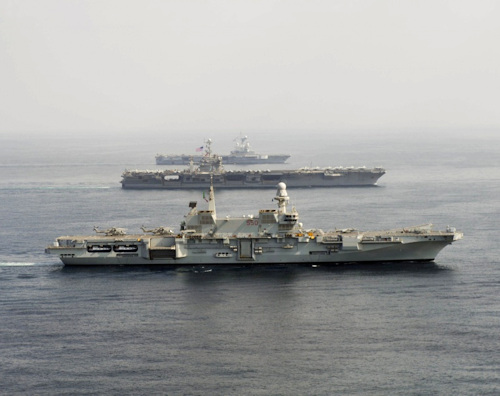 Although almost eighty years have passed since the operation Judgement and from the battle of Cape Matapan - in which the real winning card available to the English fleet under the orders of Admiral Andrew Cunningham was the aircraft carrier Wonderful, whose air force had: unearthed the Italian units immobilizing them, defended the British naval team and neutralized the enemy information service - within the European Union no more than the Italians should be aware of how useful the aircraft carriers know, including the Mediterranean. Unless one deludes himself that he faces eternal conflict situations at low or very low intensity, during which, for almost thirty years, US, NATO, UN or EU forces have benefited from superiority from time to time. overwhelming, especially in terms of air power.
Although almost eighty years have passed since the operation Judgement and from the battle of Cape Matapan - in which the real winning card available to the English fleet under the orders of Admiral Andrew Cunningham was the aircraft carrier Wonderful, whose air force had: unearthed the Italian units immobilizing them, defended the British naval team and neutralized the enemy information service - within the European Union no more than the Italians should be aware of how useful the aircraft carriers know, including the Mediterranean. Unless one deludes himself that he faces eternal conflict situations at low or very low intensity, during which, for almost thirty years, US, NATO, UN or EU forces have benefited from superiority from time to time. overwhelming, especially in terms of air power.
However, this is not the future scenario that allows us to glimpse the movements taking place in the international arena, especially in an era when the mare nostrum of Romana memoria increasingly assumes the appearance of a great channel of connection between the Atlantic and Indian-Pacific oceanic expanses, where the naval forces of medium and large powers (ascending or declining as they are) are, and will increasingly be, active, true touchstones of last resort for the evaluation of the stages of progress of the European unification process.
With this in mind, the Fincantieri-STX operation, signed with the signature, last 2 February, of the agreement that will see the Italian naval group take the reins of the Saint-Nazaire plants (through the purchase of 50% of capital for 59,7 millions of euro following a negotiation with the transalpine government that proved to be more complicated than expected), is an opportunity not to waste to develop an Italian-French industrial partnership around which aggregate a shipbuilding center continental, essential equipment for the creation of technological-industrial base on which to base a future European defense.
(photo: US Navy / web - USS nuclear power station USS Carl Vinson opens)

